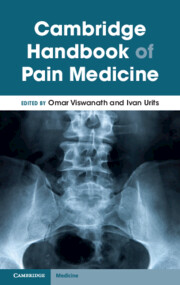Book contents
- Cambridge Handbook of Pain Medicine
- Cambridge Handbook of Pain Medicine
- Copyright page
- Contents
- Contributors
- Pain Handbook Introduction
- Part I Introduction to Pain: Pain Signaling Pathways
- Chapter 1 Central Neuropathic Pain Signaling Pathways
- Chapter 2 Cannabinoids Pain Signaling Pathways
- Chapter 3 The Microbiome and Chronic Pain Syndromes
- Part II Common Categories of Pharmacologic Medications to Treat Chronic Pain
- Part III Chronic Pain Conditions Head and Neck
- Part IV Spine
- Part V Extremities
- Part VI Misc
- Part VII Adjunctive Therapy
- Index
- References
Chapter 2 - Cannabinoids Pain Signaling Pathways
from Part I - Introduction to Pain: Pain Signaling Pathways
Published online by Cambridge University Press: 01 December 2023
- Cambridge Handbook of Pain Medicine
- Cambridge Handbook of Pain Medicine
- Copyright page
- Contents
- Contributors
- Pain Handbook Introduction
- Part I Introduction to Pain: Pain Signaling Pathways
- Chapter 1 Central Neuropathic Pain Signaling Pathways
- Chapter 2 Cannabinoids Pain Signaling Pathways
- Chapter 3 The Microbiome and Chronic Pain Syndromes
- Part II Common Categories of Pharmacologic Medications to Treat Chronic Pain
- Part III Chronic Pain Conditions Head and Neck
- Part IV Spine
- Part V Extremities
- Part VI Misc
- Part VII Adjunctive Therapy
- Index
- References
Summary
Endogenous cannabinoid system was discovered in the early 1990s. The endocannabinoid system includes cannabinoid receptors, ligands, and metabolic enzymes found within the central nervous system (CNS). Inhibition or slowing of the degradation of endocannabinoids in select tissues may confer analgesic or anxiolytic effects. Cannabinoids are becoming increasingly prescribed and studied as potential analgesic agents. Cannabinoid therapy may offer a viable alternative to opioids for management of chronic pain. Studies have demonstrated the presence of endocannabinoids and cannabinoid receptors throughout the nervous system. Cannabinoids have been shown to induce analgesic effects through mechanisms different from traditional antinociceptive pathways. Investigations of the clinical applications of cannabinoids have been limited. Clinical trials suggest that extracts containing THC or its derivatives may be efficacious in the treatment of inflammatory, neuropathic, and oncologic pain. Pharmacologic agents aimed at increasing levels of endogenous endocannabinoids may represent an alternative way of producing analgesia. There is a need for further double-blinded placebo-controlled clinicals to support the use of cannabinoids for pain control.
- Type
- Chapter
- Information
- Cambridge Handbook of Pain Medicine , pp. 14 - 25Publisher: Cambridge University PressPrint publication year: 2023



